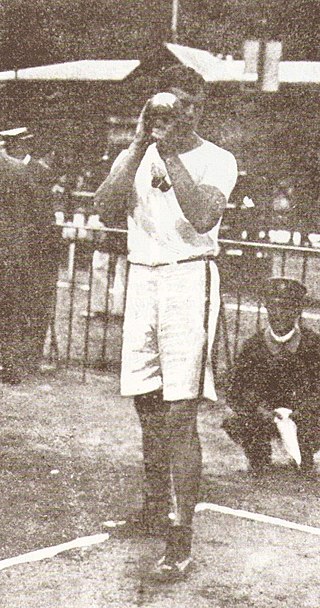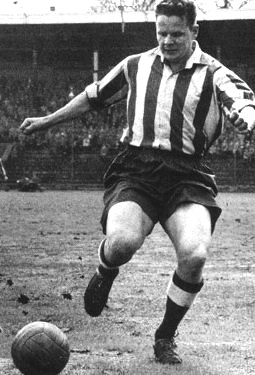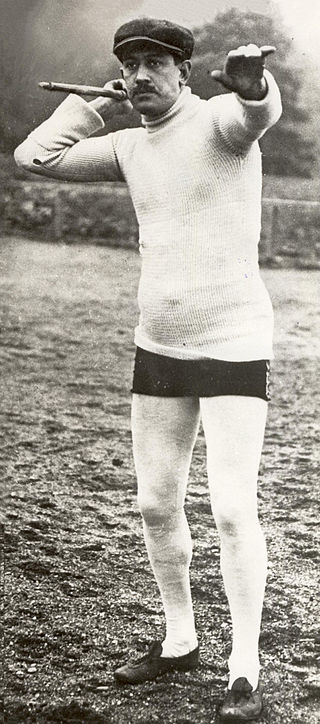
Jeu de paume was an event contested at the 1908 Summer Olympics, the only time the Summer Olympic Games featured the sport as a medal event.

Ice hockey tournaments have been staged at the Olympic Games since 1920. The men's tournament was introduced at the 1920 Summer Olympics and was transferred permanently to the Winter Olympic Games program in 1924, in France. The women's tournament was first held at the 1998 Winter Olympics.

The men's 60 metres was the shortest of the track races at the 1900 Summer Olympics in Paris, which was the first time the event was held. It was held on 15 July 1900. 10 athletes from 6 nations competed. Five preliminary heats were scheduled, though only two were actually held. The top two athletes from each of the heats advanced to the final, resulting in a final race that featured three United States runners and an Australian. Hurdle specialist Alvin Kraenzlein of the United States won the event, with his countryman Walter Tewksbury in second and Australian Stan Rowley earning bronze.

The men's 100 metres was a sprinting event on the athletics programme at the 1900 Summer Olympics in Paris. It was held on July 14, 1900. 20 athletes from nine nations competed. The event was won by Frank Jarvis of the United States, the second of three straight gold medals by different Americans in the event. Australia medaled in the event for the first time, a bronze by Stan Rowley.

The men's 400 metres was a track & field athletics event at the 1900 Summer Olympics in Paris. It was held on July 14, and July 15, 1900. The races were held on a track of 500 metres in circumference. 15 athletes from six nations competed.

The men's marathon was a track & field athletics event at the 1900 Summer Olympics in Paris. It was held on July 19, 1900. 13 athletes from five nations competed in the marathon, which used a distance of 40.26 kilometres.

The men's high jump was a track & field athletics event at the 1900 Summer Olympics in Paris. It was held on July 15, 1900. Eight athletes from seven nations competed in the high jump. The event was won by Irving Baxter of the United States, the nation's second consecutive victory in the men's high jump. Great Britain and Hungary each took medals in their first appearance in the event.

The men's pole vault was a track & field athletics event at the 1900 Summer Olympics in Paris. It was held on July 15, 1900. Eight athletes from five nations competed in the pole vault.

The men's long jump was a track & field athletics event at the 1900 Summer Olympics in Paris. It was held on July 14 and July 15, 1900. 12 athletes from six nations competed. The event was won by Alvin Kraenzlein of the United States, the second consecutive victory for the American team. Myer Prinstein, also an American, took silver. Patrick Leahy, an Irish athlete competing for Great Britain, took bronze; it was the first long jump medal for a non-American athlete as the United States had swept the 1896 medals.

The men's triple jump was a track & field athletics event at the 1900 Summer Olympics in Paris. It was held on July 16, 1900. 13 athletes from six nations competed. The event was won by Myer Prinstein of the United States, the nation's second consecutive victory in the men's triple jump. Prinstein became the first, and through the 2016 Games, only, person to have won both the long jump and the triple jump. James Brendan Connolly took second, making him the first man to medal twice in the triple jump. Lewis Sheldon finished third, completing what would later be known as a medal sweep.

The men's shot put was a track & field athletics event at the 1900 Summer Olympics in Paris. It was held on July 14 and July 15, 1900. 11 shot putters from five nations competed. The event was won by Richard Sheldon of the United States, the nation's second consecutive victory in the men's shot put. Josiah McCracken took silver and Robert Garrett took bronze, completing an American medal sweep.

The men's discus throw was a track & field athletics event at the 1900 Summer Olympics in Paris. It was held on July 14 and July 15, 1900. 17 discus throwers from nine nations competed. The event was won by Rudolf Bauer of Hungary, the nation's first victory in the men's discus throw. František Janda-Suk gave Bohemia its first medal in the event, also in that nation's first appearance. Richard Sheldon's bronze put the United States in the top three for the second consecutive Games.

The men's hammer throw was a track & field athletics event at the 1900 Summer Olympics in Paris, the discipline's first Olympic appearance. It was held on July 16, 1900. Five hammer throwers from two nations competed. The event was won by John Flanagan of the United States, the first of his three consecutive victories in the hammer throw. The American team swept the medals, with Truxtun Hare finishing second and Josiah McCracken third.

The men's standing long jump was one of six jumping events on the athletics at the 1908 Summer Olympics programme in London. The competition was held on Monday, July 20, 1908. Twenty-five long jumpers from eleven nations competed. NOCs could enter up to 12 athletes. The event was won by Ray Ewry of the United States, his third consecutive victory in the event. Ewry won all eight standing jump events from 1900 to 1908 as well as both events at the 1906 Intercalated Games. Konstantinos Tsiklitiras of Greece took silver. American Martin Sheridan earned bronze.

The Swedish Ice Hockey Association in Swedish, is an association of Swedish ice hockey clubs. It was established in Stockholm on 17 November 1922 by representatives from seven clubs. Before then, organized ice hockey in Sweden had been administered by the Swedish Football Association. In 1920, Sweden became a member of the International Ice Hockey Federation (IIHF). In addition to ice hockey, SIF is also responsible for inline hockey.

Oskar Gösta Leonard "Knivsta" Sandberg was a Swedish football, ice hockey, and bandy player who is best remembered for representing Djurgårdens IF. He was capped 52 times for the national team in football, eight times in ice hockey, and three times in bandy.

Eric Otto Valdemar Lemming was a Swedish track and field athlete who competed at the 1900, 1906, 1908 and 1912 Olympics in a wide variety of events, which mostly involved throwing and jumping. He had his best results in the javelin throw, which he won at the 1906–1912 Games, and in which he set multiple world records between 1899 and 1912. His last record, measured at 62.32 m, was ratified by the International Association of Athletics Federations as the first official world record.
Johan Ferdinand Nyström was a Swedish track and field athlete who competed at the 1900 Summer Olympics in Paris, France. Nyström competed in the marathon. He was one of six runners who failed to finish the event.
Daniel Slawson Horton was an American track and field athlete who competed at the 1900 Summer Olympics in Paris, France. He was born and died in New York City.

















